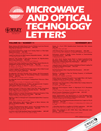Novel optical cryptography using LIP signals generated by a PANDA ring resonator
Abstract
We propose a novel optical cryptography using the dark-bright soliton conversion control in a modified add/drop (AD) optical filter. By using the control arrangement, the obtained outputs of the dynamic states of dark-bright soliton can be used to form the key suppression which can be available for communication security application, where finally, the key recovery can be obtained by controlling the AD filter outputs. The optical cryptography part consists of an AD filter which is used to generate the encrypted and decryption keys from the optical keys (LIP signals), and a Mach–Zehnder interferometer is also used for multiplexing and de-multiplexing operations. The simulation results obtained have shown that the proposed system can be achieved, which can be used to form high security communication. © 2011 Wiley Periodicals, Inc. Microwave Opt Technol Lett 53:2575–2580, 2011; View this article online at wileyonlinelibrary.com. DOI 10.1002/mop.26324




